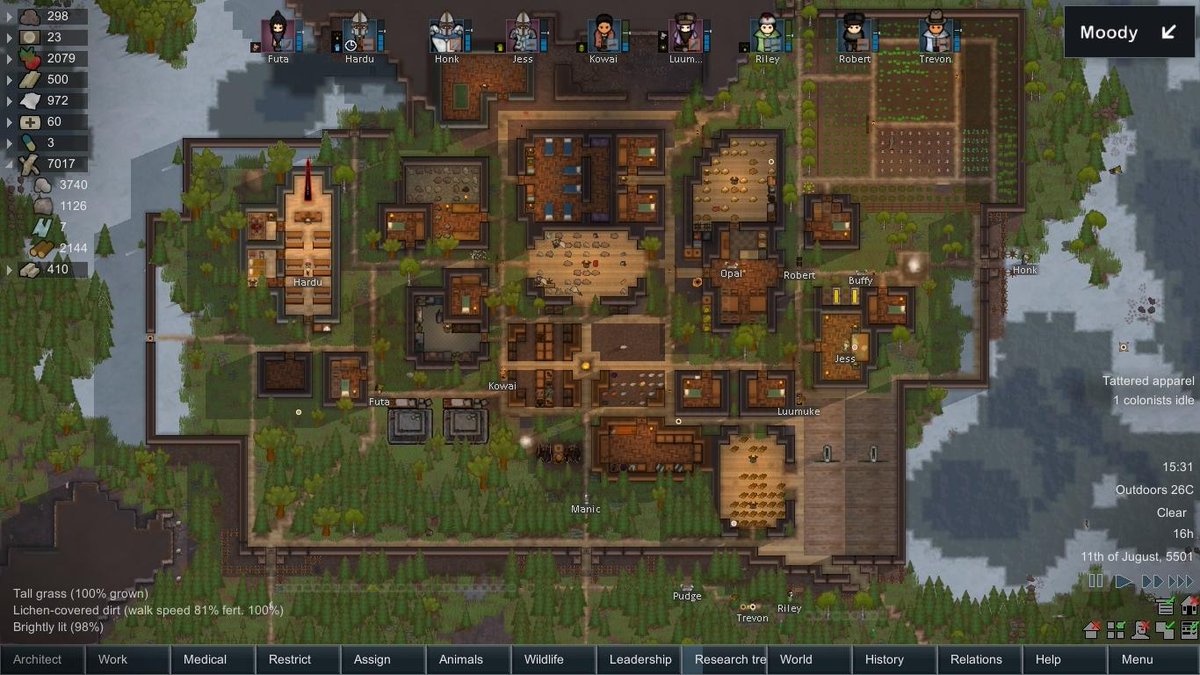

(Flat terrain lack ores to mine and is difficult to defend, and a mountain base has advantages but is more "advanced", taking longer to dig in the beginning and tending to suffer from bug infestations later on.) Large hills have plenty of ores and hills to build against, but less open land to build on and farm. Small hills have some ores but the hills still do not provide much protection. You will also want to pay attention to the terrain type - try for " small hills" or " large hills".

Try between latitude 30 and 40 or so - too far south, near the equator, will be brutally hot very soon (summer), and too far north will have unforgiving winters. You want a map with a growing season that lasts from at least spring to fall, but probably not "all year" (that's very hot). Now, look in the info tab (lower left on the screen). Bonus points for a river/creek, but hardly necessary. Once the world is created, pick a temperate forest biome to start, hopefully not too far from friendly(ish) tribes - the yellows and purples. Write it down for reference if you might want to duplicate your map later, once you know the game better.) (* The "seed" is just a random word, lower/upper case sensitive. The default dimensions is a good size that won't cause too much lag. You can play with the seed* and map size of the world, but it isn't anything that will make a big difference to you yet. (Note that these can be changed later as often as you wish, as you play the game, so don't worry too much about which one now.) You can do your own research in the previous link if you wish, but it is recommended to choose Cassandra Classic on Strive to Survive to get a feel for how the game is designed to play out. The storytellers only determine the random events that occur during your game. You can pick one of the 3 AI Storytellers, and a difficulty level. This guide assumes that you're choosing the classic "Three Crashlanded Survivors" scenario it's a good "first game" start, and many veteran players prefer it. There are 4 prebuilt scenarios to choose from. The first thing you'll be able to pick is a story scenario. Detailed analysis, tips and tricks, and "best practices" will be skipped in this guide, excepting only to avoid "game over" level pitfalls.įor a more detailed basic introduction see Basics. Anyone who has tried using grenades against bugs knows exactly why you need this.As its name suggests, this is a quick guide for starting quickly - when you want to play now. Ground Targeter - Holding left shift allows you to target the tile a creature is standing on, rather than targeting the creature itself. Hands are not outside - Power armor covers hands and feet. Share the load - allows multiple pawns to deliver resources to the same blueprint at the same time instead of the vanilla arbitrary limit of 1 hauler at a time. Show draftees weapon - displays the equipped weapon of drafted pawns below their icon on the pawn bar. Smarter Construction - pawns no longer wall themselves in when you create construction jobs to fill in an area. Has a much bigger impact on the game than you'd expect, as it reminds you to trade with your neighbors more consistently. Restock Notification - sends a letter when a settlement you traded with restocks. Almost There! - lets you control when your caravan moves and when it stops instead of it arbitrarily stopping and going at certain times of day.īridge color tweak - makes bridges the same color as floors of the same material, so they match and are seamless.


 0 kommentar(er)
0 kommentar(er)
